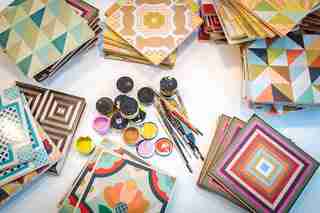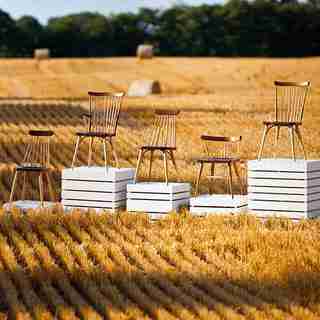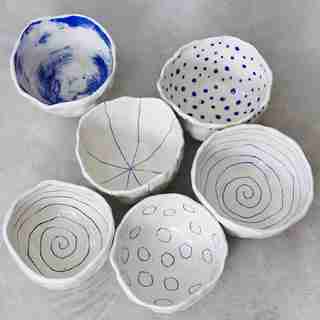Meet the New Wave of American Crafters

Mirth Studio, Charleston, South Carolina
For painter Sally Bennett, creating Mirth Studio was a personal solution to a dilemma encountered while she redecorated her Charleston home. “I wanted the look of an old hand-painted floor but did not want to get down on the floor and paint it,” Bennett recalls. Instead, she devised wood tiles digitally printed with her hand-painted designs and engineered using only a thin layer of actual hardwood, which is locally sourced.

Keating Woodworks, Colorado Springs, Colorado
Classic Windsor chairs take on modern silhouettes in the Colorado Springs studio where Geoffrey Keating runs Keating Woodworks. A fifth-generation furnituremaker, Keating took a roundabout route to the trade, pursuing a degree in theology before finding a place in the craft of his ancestors. He favors American black and claro walnut, all salvaged or sustainably harvested, and aims “to stay true to traditional methods of joinery woodworking.”

Btw Ceramics, Brooklyn
Greenpoint, Brooklyn–based Brooke Winfrey’s charming ceramics derive their aesthetic from the very process of being handmade. Subtly uneven shapes, wavering lines, and even fingerprints are evidence of the ceramist’s work, in which she “approaches each piece as its own creation, where the irregularities are embraced . . . and the artist’s hand is blatantly and proudly shown.” Her pinch bowls, pictured, are equal parts graphic and subdued.
ANK Ceramics, Lincolnville, Maine
In an interview earlier this year, ceramist Ariela Kuh declared, “I like things that agree with their surroundings but also quietly disrupt them.” Subtle in color and unique in form, her designs, like the bud vases pictured here, are eye-catching but quietly pleasing. Kuh, whose six-year-old company has recently gained recognition after creating pottery for the Manhattan eatery Momofuku Ko, crafts all of her work by hand in her Maine studio.
Fireclay Tile, San Francisco
Long before sustainability and handmade were design buzzwords, a ten-year-old Paul Burns was crafting tiles in the California studio his uncle ran. Now, some five decades later, he helms San Francisco–based Fireclay, alongside Eric Edelson, where these two ideals run deep. The company produces red clay tiles made from at least 70 percent recycled materials, as well as recycled-glass tile. Shown is the Sakura collection.
Studio Moe, Portland, Oregon
Husband-and-wife team Andrew and Amanda Moe find the perfect balance between the clean design of Scandinavia and the nature-infused lifestyle of the Pacific Northwest in their three-year-old Portland studio. Using sustainably harvested American ash and salvaged Oregon walnut, Andrew creates elegantly simple furnishings while Amanda oversees the brand as creative director. Pictured are dining chairs from the Oslo collection.
Fort Standard, Brooklyn
After studying side-by-side at both New York’s Pratt Institute and the Bauhaus in Weimar, Germany, furniture and product designers Greg Buntain and Ian Collings officially joined forces in their Brooklyn studio Fort Standard. “Our discussions, observations, drawings, and makings all layer themselves into a medium that is our work,” explains Collings, which results in an aesthetic rooted in nature and manifested in a slew of high-quality products, such as the Plank maple cutting boards, pictured.
Aaron Poritz, Brooklyn/Leverett, Massachusetts
“I don’t like the idea of being tied to one style,” says Aaron Poritz. Categorizing his furniture as functional and fun, Poritz aims to create pieces that are modern but “not flashy.” He grew up frequenting his sculptor father’s studio and now works with craftsmen in Brooklyn and Leverett, Massachusetts, to realize his own designs, such as the Kaplan desk, shown.
Michael Robbins, Philmont, New York
“Rustic yet refined” is how self-taught woodworker Michael Robbins describes the pieces he produces in his studio, a converted garment factory in New York’s Hudson Valley. His furniture, like the Mohawk credenza pictured, marries a modern silhouette with rich materials.
Clé, San Francisco
“My environment is what allows my creativity to flourish,” explains Deborah Osburn, founder of San Francisco–based Clé. Perhaps nowhere is that more evident than in the designer’s Indigo dip tiles, shown, whose striated blues recall the San Francisco Bay that she so loves. In addition to Osburn’s own creations, her company carries tiles from designers around the globe, each an attempt to “imagine tiles the world has never seen.”
Ampersand, Cincinnati
Form and function truly go hand in hand at Ampersand, where founder Tim Karoleff and managing director Greg Lutz strive to “enrich human spaces with friendly, functional, handsome objects,” such as the hand-turned Swell bowls, pictured. Ninety-five percent of Ampersand’s materials are sourced from locations within 50 miles of its hometown of Cincinnati.
Dana Bechert, Nottingham, Pennsylvania
Dana Bechert began her education at her potter mother’s wheel before apprenticing to ceramist Leslie Thompson, from whom she learned the intricate carved process shown here on her black-and-white vases. “I believe that the more quality items one possesses, the less junk they need overall,” Bechert says.
Asher Israelow, Brooklyn
Design is a dance between old and new for furnituremaker Asher Israelow, who says he aims to imbue each of his pieces with simultaneous “heritage quality” and “a forward-thinking contemporary edge.” Israelow plays continuously with technique at his Brooklyn Navy Yard studio, always searching for new ways to use traditional materials, like in the Lincoln chair, shown.
Silvia Song, Berkeley, California
Brazilian-born, California-based Silvia Song never quite finishes her designs on her own. The artist’s handcrafted wares are made to weather over time, developing a patina that makes each piece stunningly unique. Her hand-turned maple bowls, shown here, achieve their deep hue from a traditional Japanese vat-dyeing method.
Thos. Moser, Auburn, Maine
Thos. Moser is a company built on longevity. Furnishings produced by the studio are made from solid American hardwoods, such as walnut, cherry, maple, or oak, sustainably sourced from Pennsylvania’s Allegheny Valley once they reach maturity—which can take up to 125 years. Lately, the brand has turned to more contemporary designs, like this Danish Modern–inspired Cumberland stool.
Frances Palmer Pottery, Weston, Connecticut
“I love the process of changing ideas into form,” says Frances Palmer, who worked first as a printmaker and now is a potter in the Connecticut studio where she creates her eponymous line. Palmer has been crafting her whimsical takes on traditional ceramic forms, like the oxide vase shown, since 1987, deriving happiness from “sending them out into the world for others to live with and enjoy.”
Colleen & Eric, Brooklyn
The origin of this studio almost begs for a movie adaptation: “While on our honeymoon in Paris, we made the decision that it was time to take a few of our napkin drawings into real life,” recalls Colleen Whiteley, one half of the husband-and-wife creative team of Colleen & Eric. Since then, the duo has been sourcing local wood to devise distinctive furniture like the Grand Tambour console, shown. All designs are created in-house with water-based glues and natural finishes.
MMaterial, New York City
Fernando Mastrangelo’s functional sculpture is a brilliantly unexpected juxtaposition of color and material. Originally creating under the brand AMMA Studio, Mastrangelo has recently gone out on his own to form MMaterial by Fernando Mastrangelo Studio, which seeks “to truly fuse the two worlds between art and design” The sand-and-silica drums, pictured, are a prime example.
Groundwork Home, Philadelphia
Since 1993, Brian Foster and Ernie Sesskin have rejected mass production and global shipping in favor of sustainability and local crafting. A healthy mix of rustic and modern-leaning designs, Groundwork’s pieces are all made to order by either the studio itself or Amish and Mennonite craftspeople in neighboring Lancaster County. Tree-root tables, like the one shown here, are reclaimed by-products of the Michigan lumber industry.
Egg Collective, New York City
Stephanie Beamer, Crystal Ellis, and Hillary Petrie met as freshmen in architecture school and became fast friends. Six years later, in 2011, the trio established Egg Collective, a workshop celebrating handmade work and natural materials. All wood items, including the Francis desk and Densen chair, pictured, are made in the collective’s Brooklyn shop, while other products are crafted in small shops throughout the city.
New Ravenna, Exmore, Virginia
Global inspiration meets hometown technique in this tile company founded by Sara Baldwin. A native of Virginia’s Eastern Shore, where New Ravenna is headquartered, the designer credits the region’s “bountiful and beautiful habitat” for the spirit of her work. Shown is the Orson tile, a hand-cut mosaic with Calacatta marble and 24K-gold glass, devised by Baldwin and executed by artisans in her studio.
Patrick Cain Designs, Los Angeles
Patrick Cain might take the cake for most spectacular harvesting method. When NASA’s retired Endeavour space shuttle made its way by land to Los Angeles’s California Science Center, the designer followed its bizarre procession, claiming the wood felled to make way for the oversize trailers. For his metalwork, like this copper-top table, Cain partners with a father-son-grandson trio in East L.A. who laser-cut and hand-weld every item.